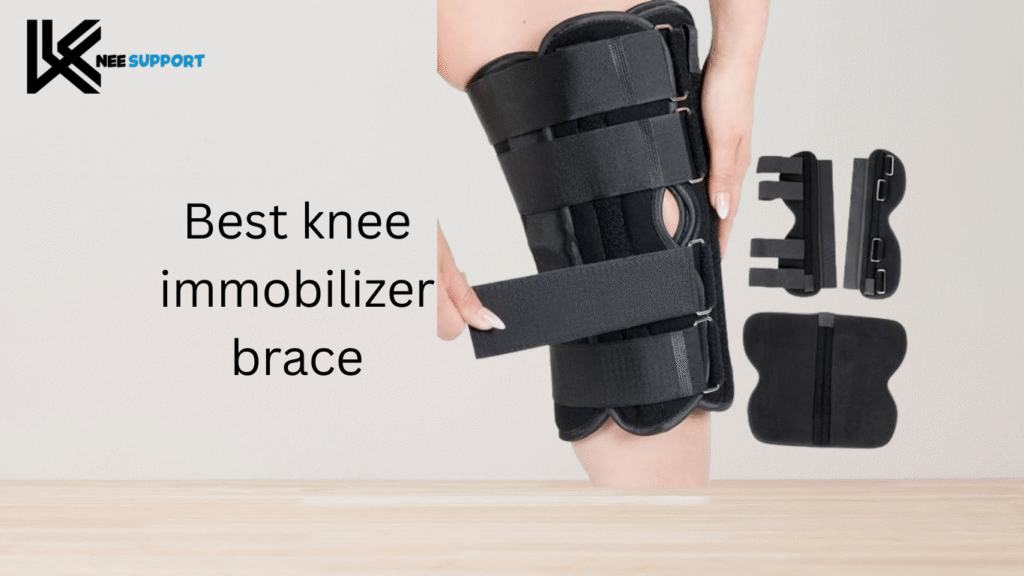
A knee immobilizer brace is a necessity for anyone recovering from an injury or surgery. This unique knee support equipment immobilizes the leg and the joint, offering stabilization and support for the duration of the sensitive convalescence. Knowledge of what these braces do and how they work is essential to a good recovery. Whether you need a hard knee immobilizer to aid the recovery process or a soft knee support to use after an acute injury, wearing a properly fitted brace can make a big difference in your rehabilitation. In this article, we’ll discuss the kinds of knee immobilization devices and their benefits and when to use them, so you’ll have the information that you need for a successful recovery.
Find out how a knee immobilizer brace for recovery through stability and support of knee injuries or post-surgery recovery.
Knee immobilizer braces are a significant part of the lives of people with knee injuries and those who have ever had knee surgery. These knee stabilizers prevent the knee from moving. They promote the healing process by restricting motion. In this post, we will discuss what knee immobilizer braces are, the different types, when to use them, and their benefits. We hope to offer informative news on knee-stabilizing braces lying around in the US market.
What is a Knee Immobilizer Brace?
A knee immobilizer is a type of brace worn after an injury to the knee to provide stabilization and protection to the joint. It assists in keeping the knee joint steady after surgery. This type of brace is often used post-surgery or post-serious injury. The brace limits how much the joint in the middle of the foot can move. It supports the knee so that it’s able to properly align. The knee immobilizer can help alleviate pain and prevent further knee injury by limiting the range of motion. In summary, it pertains to the knee healing program.
Importance of Knee Stability
Knee stability is essential in everyday activities. If the knee is unstable, which it can be, it can be painful and increase the risk for further injuries. A knee rehabilitation brace to maintain stability of the knee. Such support can help the body to self-heal. Without balance, one of your joints may not let you stand, walk, or run effectively or safely. Therefore, for the patient, a knee immobilizer can be an excellent solution in recovery.
Types of Knee Immobilizer Braces
There are several models of knee immobilizer braces, and understanding them will help you to select the proper one for the type of support you are looking for. The two primary types are stiff knee immobilizers and soft knee supports.
Rigid Knee Immobilizers
Rigid knee braces are constructed of durable material that does not allow the knee to move. They provide maximum support. This type is commonly used post major surgeries or when there is a severe injury. Rigid immobilizers allow for the ultimate in knee joint protection during the initial accelerated break-in of the injury. They make sure the healing tissues have the stability they require to mend fully.
Soft Knee Supports
Contrastingly, soft knee supports are also designed in a way that they offer moderate support with the help of flexible materials. They provide a little give but stabilize the knee. This kind is perfect when the injury isn’t too serious or if you’re in the late days of your recovery. Soft knee braces may be more comfortable to wear every day. They offer protection of the soft tissues and allow a trade-off between support and turning ability.
When to Use a Knee Immobilizer?
Some situations require the use of knee immobilizers. It is important to know when to incorporate them for the best recovery.
Post-Surgery Recovery
Following knee surgery, people frequently use a knee immobilizer. The brace has effectively stabilized the knee and will not let it move too much. It is vital that you heal properly. It provides pain and swelling management. Use of the immobilizer as directed during convalescence after surgery may accelerate the healing process dramatically.
Acute Injuries
Knee immobilizers are also helpful for acute injuries, like sprains or strains. These injuries can cause instability and pain. Wearing a knee immobilizer provides immediate support. It helps limit knee movement, which reduces further injury. This stabilization support for the knee is vital during the early stages of recovery. The brace allows the injured area to rest, promoting healing.
Key Features to Look For
There are a few things to keep in mind when you choose a knee immobilizer to provide recovery and comfort.
Adjustability and Fit
A hinged knee brace is a must. It should be tight but not too snug. When fitted properly, the brace will offer support without being too tight. It also keeps the mobile from slipping.
Material Quality
It must be made of sturdy, lightweight material. A brace may be more comfortable if it’s made of a high-quality material. They should also be breathable to prevent the area from becoming moist. A well-made brace will improve the likelihood of consistency and thus better healing results.
Weight and Portability
A light knee immobilizer is less of a hassle to wear during the day. If the brace is too heavy, it can feel cumbersome and demoralize you. Choose a brace that you can wear without interfering with your lifestyle during the healing period.
How to Wear a Knee Immobilizer
It is imperative to be able to use your knee immobilizer correctly. This understanding can improve pain control and the patient’s comfort in the postoperative period.
Fitting the Brace
There is a critical need to ensure proper fitting of the brace. Instructions come with each brace to guide you in fitting the brace. Ensure they follow these tips to make the fit just tight enough above and below your knee. Correct fit prevents brace slipping and offers optimal stability.
Daily Care and Maintenance
Proper care for the knee immobilizer is also crucial. Clean the brace as directed by the manufacturer. It kills bacteria and keeps the brace clean. Moreover, the cleaner the braces, the more comfortable they are, and the less likely they are to cause irritation to the skin.
Common Misconceptions
There are some common myths about knee immobilizers that we need to debunk.
Can You Walk with an Immobilizer?
A lot of people ask if you can walk with an immobilizer. Yes, most individuals are able to walk while wearing a functional knee brace. The orthosis is configured to be weight-bearing and support an individual. But you may need to get used to walking with it.
Are They Comfortable to Wear?
Another typical question is about comfort. At first, some might find knee immobilizers to be restrictive, but most become accustomed to the feeling with time. A well-fit brace can relieve pain and provide assurance while you heal.
Advantages of Knee Immobilizer Brace
A knee immobilizer brace has numerous benefits. These are just a few good reasons to stick with it.
Pain Relief
Knee pain relief is one of the primary benefits of a knee immobilizer. The brace restricts movement, so it can help relieve pain. This pain management ability will help you concentrate on rehabbing, not the pain.
Enhanced Mobility During Recovery
Although a knee immobilizer limits movement, it may result in an improvement in mobility on the whole. With appropriate support, you can gain more stability while you’re on the go. This increased peace of mind can also enable you to participate in some light activities, which is helpful during the recovery period.
Potential Drawbacks
Despite their advantages, knee immobilizers also have some drawbacks.
Risk of Muscle Weakness
Prolonged use of a knee immobilizer can lead to atrophy of the muscles. That’s why it’s so crucial that you adhere to the guidelines provided by your health care provider on how long you should be wearing the brace. If you are able to do the exercises as directed on a regular basis, you will be able to offset the downside.
Skin Irritation Concerns
It is common to have skin irritation from wearing a knee immobilizer for long periods of time. Checking your skin is a must. If the red spots and irritation do not disappear, and your brace is causing you pain, it is time to stop using it or make adjustments for a better fit. Proper hygiene and care can help prevent skin problems.
Conclusion
Knee immobilizer braces are essential for post-injury, surgery, and traumatic injuries to the knee joints and ligaments. These injury recovery braces give your knee the support and stability needed during the time of healing. Choosing the proper knee immobilizer, using it correctly, and knowing the benefits of using one can help make your recovery even better. If you have any knee problems, consult a physician. They can recommend the type of brace that is best for your particular needs.
FAQs
How long should I use a knee immobilizer?
How Long Should You Wear a Knee Immobilizer? Periods for wearing a knee immobilizer vary in accordance with the injury and your healthcare professional’s suggestions. They’ll instruct you on how much time it should be worn for the fastest recovery.
Is it ok to sleep with a knee immobilizer?
You are typically able to sleep in your knee immobilizer. But you should ask your doctor if it is safe for you.
Are a knee immobilizer and a knee brace the same?
No, they are not the same. The knee immobilizer does not move at all, while the typical knee brace allows for a certain amount of flexibility and movement.
How will I know if I need a knee immobilizer?
If you had knee surgery or an injury occurred recently, see your provider. It will depend on your status and how much they really should give you a knee immobilizer.
Can I wear an immobilizer while doing physical therapy?
Depending on your injury, you may need to wear an immobilizer during physical therapy. As with any rehabilitation program, always consult your doctor or therapist to determine what is best for you.
By understanding knee immobilizers and their importance in injury recovery, you’re taking the right steps toward a healthier knee and better overall quality of life.

